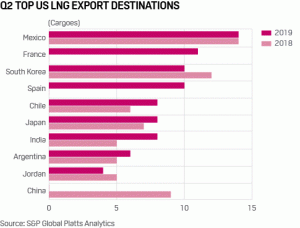US LNG exports are higher than ever: so why are some Americans unable to access natural gas?
A new report published by credit rating agency Moody’s highlights how increased exports of US LNG (liquefied natural gas) can help keep domestic natural gas prices in an optimal range. Two main takeaways from the report are that US LNG exports are expected to surpass 7 billion cubic feet per day (Bcf/d) by early 2020, and that US natural gas production is increasingly able to meet demand around the world. As the report explains:
Even with a rapidly growing US export market, we see ample supply available for export without pushing prices above the range-bound territory where prices appear mired today. On the contrary, we believe the growing US export market will help maintain a floor under natural gas prices, without which prices could tumble, threatening production aggregates.
 To the left is a chart compiled by S&P Global Platts, which compares LNG exports in 2018 vs 2019. Noteworthy increases can be seen in the destinations of France, Spain, Chile, and India. In May of 2019, gas deliveries from the top three LNG export plants in the country reached an all-time high, with a total of 4.47 Bcf/d being transported. The numbers don’t lie: the US has become a key player in LNG exports, and domestic production of natural gas is at an all-time high. And we’re increasingly able to support our allies around the world with American-produced natural gas.
To the left is a chart compiled by S&P Global Platts, which compares LNG exports in 2018 vs 2019. Noteworthy increases can be seen in the destinations of France, Spain, Chile, and India. In May of 2019, gas deliveries from the top three LNG export plants in the country reached an all-time high, with a total of 4.47 Bcf/d being transported. The numbers don’t lie: the US has become a key player in LNG exports, and domestic production of natural gas is at an all-time high. And we’re increasingly able to support our allies around the world with American-produced natural gas.
The issue lies in the fact that we have abundant supplies of natural gas, but can’t seem to move any of it within our own borders. According to an article published by the Wall Street Journal, there is a huge natural gas distribution problem in the US. Gas customers are getting refused service in New York City due to a lack of supply lines, while consumers in western Texas have reached the point where they’ve resorted to simply burning off the surplus that can’t be transported to markets across the country. The amount they are burning each day equates to roughly enough gas to fuel the entire state of Texas. Meanwhile, a real estate developer in Westchester County, New York, couldn’t complete the sale of a 66 unit housing development, because Con Edison had announced that it couldn’t service any more clients in that area. The sale, of course, fell through, and the development will likely remain vacant.
The solution is quite clear: if some people don’t have enough gas, and some people have too much, why don’t we transfer the excess natural gas to the people who need it? Seems simple enough. However, to transport these energy resources, we need to invest in natural gas pipelines – the safest, most efficient means of carrying energy supplies. All too often, plans are drawn up to begin construction on a new pipeline, which would not only move gas, but also create jobs and add to the country’s infrastructure in the process – only for the plans to be stymied, either by protestors and apprehensive state governments, or bureaucratic red tape and legal challenges to issued permits.
Transporting gas to people who need it should not be a partisan issue; especially not when the situation has begun to impact individual homeowners and real estate developers. Americans should recognize the facts: we need more pipelines, and we need them now. GAIN continues to support the responsible, timely development of our nation’s energy infrastructure.
